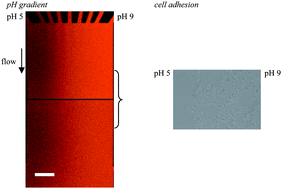Polyelectrolyte multilayers generated in a microfluidic device with pH gradients direct adhesion and movement of cells†
Abstract
In this study, multilayers from polyethylene imine,

* Corresponding authors
a
Biomedical Materials Group, Institute of Pharmacy, Center for Nanotechnology, Martin Luther University Halle-Wittenberg, Heinrich-Damerow-Strasse 4, Halle (Saale), Germany
E-mail:
thomas.groth@pharmazie.uni-halle.de
Tel: +49 0345 55 28 461
b Center for Cell Engineering, University of Glasgow, Glasgow, UK
c Electronics and Electrical Engineering, University of Glasgow, Glasgow, UK
In this study, multilayers from polyethylene imine,

 Please wait while we load your content...
Something went wrong. Try again?
Please wait while we load your content...
Something went wrong. Try again?
K. Kirchhof, A. Andar, H. B. Yin, N. Gadegaard, M. O. Riehle and T. Groth, Lab Chip, 2011, 11, 3326 DOI: 10.1039/C1LC20408D
To request permission to reproduce material from this article, please go to the Copyright Clearance Center request page.
If you are an author contributing to an RSC publication, you do not need to request permission provided correct acknowledgement is given.
If you are the author of this article, you do not need to request permission to reproduce figures and diagrams provided correct acknowledgement is given. If you want to reproduce the whole article in a third-party publication (excluding your thesis/dissertation for which permission is not required) please go to the Copyright Clearance Center request page.
Read more about how to correctly acknowledge RSC content.
 Fetching data from CrossRef.
Fetching data from CrossRef.
This may take some time to load.
Loading related content
